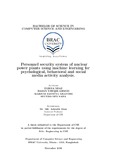| dc.contributor.advisor | Alam, Dr. Md. Ashraful | |
| dc.contributor.author | Neaz, Fabiha | |
| dc.contributor.author | Ahmed, Hasan Tawqir | |
| dc.contributor.author | Granthi, Marium Tasnuva | |
| dc.contributor.author | Saha, Shuvro Dev | |
| dc.date.accessioned | 2019-04-17T09:52:09Z | |
| dc.date.available | 2019-04-17T09:52:09Z | |
| dc.date.copyright | 2018 | |
| dc.date.issued | 2018-12 | |
| dc.identifier.other | ID 14301031 | |
| dc.identifier.other | ID 14101203 | |
| dc.identifier.other | ID 14301020 | |
| dc.identifier.other | ID 14101200 | |
| dc.identifier.uri | http://hdl.handle.net/10361/11726 | |
| dc.description | This thesis is submitted in partial fulfilment of the requirements for the degree of Bachelor of Science in Computer Science and Engineering, 2018. | en_US |
| dc.description | Cataloged from PDF version of thesis. | |
| dc.description | Includes bibliographical references (pages 39-40). | |
| dc.description.abstract | In this research, a novel Personnel Security Model is designed and demonstrated for detecting
suspicious people in an organization especially for nuclear power plants. The proposed system
composed of three subsystems and a final decision making system such as i. Application
software for performing a dynamic questionnaire session of individual employee of the power
plant, ii. Eye blink and response time counter for lie detection during the questionnaire
session and iii. Another sub system is also introduced for sentiment analysis from social
media activities. Then, based on the outputs of three sub-systems, final decision is generated.
In first sub-system, According to the science of psychology, suspicious people can be detected
by asking some questions, by their response time and their eye blinking, lie can also detected.
On the other hand their social media posts can also reflect a person’s actual psychological
condition. In this study a person’s answers of the psychological questions, their eye blinking
and response time corresponding to the question, and their social media activity are taken in
consideration to extract as parameters or features for the final prediction model to find out
whether a person is suspicious or not. Experimental results and analysis have been presented
to justify the validity of the proposed method. | en_US |
| dc.description.statementofresponsibility | Fabiha Neaz | |
| dc.description.statementofresponsibility | Hasan Tawqir Ahmed | |
| dc.description.statementofresponsibility | Marium Tasnuva Granthi | |
| dc.description.statementofresponsibility | Shuvro Dev Saha | |
| dc.format.extent | 43 pages | |
| dc.language.iso | en | en_US |
| dc.publisher | Brac University | en_US |
| dc.rights | Brac University theses are protected by copyright. They may be viewed from this source for any purpose, but reproduction or distribution in any format is prohibited without written permission. | |
| dc.subject | Personnel security | en_US |
| dc.subject | Nuclear power plant | |
| dc.subject | Machine learning | |
| dc.subject | Social media activity | |
| dc.subject.lcsh | System security. | |
| dc.subject.lcsh | Nuclear power plants--Safety measures. | |
| dc.title | Personnel security system of nuclear power plants using machine learning for psychological, behavioral and social media activity analysis. | en_US |
| dc.type | Thesis | en_US |
| dc.contributor.department | Department of Computer Science and Engineering, Brac University | |
| dc.description.degree | B. Computer Science and Engineering | |

